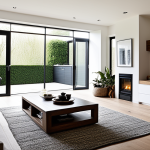Essential Strategies for Maximising Comfort in Compact UK Homes
Creating comfort in small UK homes requires thoughtful small space transformation strategies that respect typical British architectural features. Prioritizing multifunctional design is key: furniture and layouts should serve multiple purposes, fitting the scale of UK living rooms, bedrooms, and kitchens without overcrowding. For instance, a fold-out dining table can double as workspace, maximizing usability in limited areas.
Another effective approach is to leverage smart zoning techniques. This means defining separate living areas using rugs, furniture placement, or subtle room dividers—especially helpful in open-plan or studio-style UK flats. These zones help the brain perceive a larger, more organised space rather than one cramped room trying to do everything.
In the same genre : How Can You Enhance Your Home’s Aesthetic with Simple DIY Projects?
Finally, implementing clever layout choices tailored to maximize space UK homes involves understanding common features like narrow corridors, alcoves, and bay windows. Arranging furniture to complement these quirks—such as placing seating near natural light or using slim storage units along passageways—enhances both movement and comfort. Combining these strategies creates a home that feels roomy, practical, and welcoming despite its compact size.
Innovative Space-Saving Furniture and Storage Solutions
Choosing the right space-saving furniture UK is vital to achieve UK home comfort in small spaces. Modular pieces that fold away or serve multiple functions allow rooms to adapt throughout the day, ideal for typical compact UK flats. For example, a sofa bed or fold-away desk frees up floor area when not in use, helping to maximize space UK efficiently.
This might interest you : How Can You Optimize Your Space for a Clutter-Free Home?
Under-stair storage is another clever technique. Many British homes have stairs occupying limited space; transforming this area into built-in cupboards or shelving units significantly increases storage without intruding on living zones. Utilizing alcoves similarly taps into neglected corners, providing bespoke storage solutions that blend seamlessly with varied UK floorplans.
When selecting or customising furniture, focus on functionality, size, and style that complements the home’s character. Incorporating built-in storage into walls or under furniture reduces clutter and improves flow, which is especially important in compact settings.
By integrating space-saving furniture UK with innovative storage strategies like under-stair or alcove units, residents gain both practicality and aesthetic appeal. This combination supports a more organised, spacious feel crucial for maximising comfort in small UK homes.
Essential Strategies for Maximising Comfort in Compact UK Homes
Creating UK home comfort starts with prioritising multifunctional design that fits typical British properties. Furniture should adapt to daily needs, serving more than one purpose, which helps maximize space UK homes so desperately require. For example, a chest that doubles as seating or a coffee table with storage keeps areas uncluttered and flexible.
Smart zoning techniques further enhance small spaces. By using rugs, shelving units, or lighting to subtly define areas, residents can mentally separate living, dining, and work zones without erecting walls. This strategy is especially useful in open-plan flats common across the UK, as it preserves openness while creating distinct functional zones.
Adapting layouts to typical UK floorplans is equally crucial. Narrow hallways, bay windows, and alcoves often present challenges that become opportunities when approached thoughtfully. Arranging furniture to flow naturally with these features maintains movement and light, reinforcing the sense of space.
Together, these strategies ensure small homes feel spacious and comfortable. Emphasising multifunctionality, clear zoning, and layout cleverness addresses unique British home constraints and maximises every square foot effectively.
Essential Strategies for Maximising Comfort in Compact UK Homes
Achieving UK home comfort in compact spaces starts with small space transformation focused on multifunctional design. Furniture must balance form and function, adapting to varied daily activities without overwhelming typical British rooms. For example, a bench with hidden storage or a pull-out desk maximises usability while conserving square footage. This approach directly helps maximize space UK properties offer, turning limitations into opportunities.
Smart zoning further refines comfort by visually and functionally separating areas—even in open-plan flats common across the UK. Using rugs, furniture arrangements, or subtle dividers creates clearly defined living, dining, and work zones. This method helps residents mentally expand the space, contributing to a more organised and relaxed atmosphere.
Layout choices tailored for typical UK floorplans complement these strategies. Spotting natural light sources like bay windows or preserving movement flow through narrow corridors enhances both functionality and comfort. Clever positioning of furniture near these features extends the perception of openness and supports daily living needs.
Together, these three core tactics—multifunctional design, smart zoning, and thoughtful layout—form a practical framework to maximize space UK homes realistically afford while elevating their comfort and appeal.
Essential Strategies for Maximising Comfort in Compact UK Homes
Achieving UK home comfort in small spaces hinges on effective small space transformation that respects British property features. Prioritising multifunctional design means selecting furniture that adapts to multiple daily uses—such as storage benches or foldable tables—helping to maximize space UK homes offer without clutter.
Smart zoning techniques further improve comfort by visually dividing living areas. In open-plan flats common in the UK, using rugs, shelving, or lighting distinctions creates separate zones for relaxing, dining, and working. This approach allows residents to mentally expand their space, supporting better flow and organisation within compact rooms.
Clever layout choices tailored to typical UK floorplans are equally essential. Narrow corridors, bay windows, and alcoves can be harnessed rather than hinder space. For example, positioning seating near natural light or choosing slim-profile furniture for hallway areas enhances movement and daylight use. Such thoughtful arrangements provide structure without sacrificing openness.
Together, these focused strategies—multifunctional design, smart zoning, and layout adaptability—empower residents to confidently maximize space UK homes naturally limit while ensuring a cozy, practical, and inviting atmosphere.







